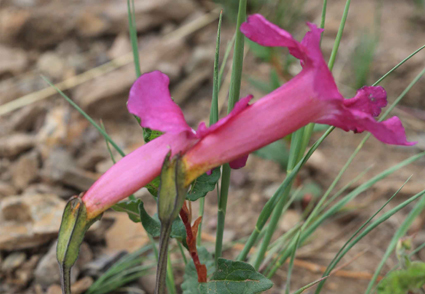Abstract
The Hengduan Mountains, as one important biodiversity hotspots in the world, is notable for its high habitat heterogeneity and extreme plant diversity which including many endemics species. Incarvillea uniflora, a new species is described from Hengduan Mountains. The new species is similar to I. himalayensis in having red corolla, stemless, solitary flower, capsule 4-angled and winged seeds, but differs by the characters of stable simple leaves, long triangular calyx lobes and solitary or clustered flowers. It is considered to be Data Deficient (DD) due to the lack of further field investigation.
References
Boufford, D.E. (2014) Hengduan Mountains, hotspot of biodiversity. Arnoldia 72: 24–35.
Chen, S.T., Guan, K.Y. & Zhou, Z.K. (2006) A new subgenus of Incarvillea (Bignoniaceae). Annales Botanici Fennici 43: 288–290.
Chen, S.T., Guan, K.Y., Zhou, Z.K., Olmstead, R. & Cronk, Q. (2005) Molecular phylogeny of Incarvillea (Bignoniaceae) based on ITS and trnL-F sequences. American Journal of Botany 92: 625–633. https://doi.org/10.3732/ajb.92.4.625
Deng, Y.F. (2020) Bignoniaceae. In: Deng, Y.F., Li, Z.Y., Wang, Q. & Peng, H. (eds.) Flora of Pan-Himalaya 46. Science Press, Beijing, pp. 444–511.
Fedtsch, B.A. (1915) Notes on some new or rare plants 1-3. Izv?stija Imperatorskago Botani?eskago Sada Petra Velikago 15: 399–401.
Grey-Wilson, C. (1998) A new look at Incarvillea subgenus Pteroscleris. The New Plantsman 5: 77–98.
IUCN (2012) IUCN Red List Categories and Criteria, Version 3.1. Gland, Switzerland and Cambridge, U.K. IUCN Species Survival Commission, 38 pp. Available from: http://cmsdocs.s3.amazonaws.com/RedListGuidelines.pdf (accessed 20 October 2021)
Jussieu, A.L. de. (1789) Genera Plantarum. Apud viduam Herissant et Theophilum Barrois, Parisiis, 498 pp.
Léveillé, A.A.H. (1915) Catalogue des Plantes de Yun-Nan (2). Le Mans, Chez l’Auteur, pp. 16–32.
Li, N. & Hua, B.Z. (2020) Two new species of Panorpa (Mecoptera, Panorpidae) from the Hengduan Mountains in Yunnan, China. Journal of Asia-Pacific Entomology 23: 138–145. https://doi.org/10.1016/j.aspen.2019.12.005
Rana, S.K., Luo, D., Rana, H.K., Chen, S. & Sun, H. (2021b) Molecular phylogeny, biogeography and character evolution of the montane genus Incarvillea Juss. (Bignoniaceae). Plant Diversity 43: 1–14. https://doi.org/10.1016/j.pld.2020.09.002
Rana, S.K., Rana, H.K., Luo, D. & Sun, H. (2021a) Estimating climate-induced “Nowhere to go” range shifts of the Himalayan Incarvillea Juss. using multi-model median ensemble species distribution models. Ecological Indicators 121: 107127. https://doi.org/10.1016/j.ecolind.2020.107127
Grierson, A.J.C. (1961) A revision of the genus Incarvillea. Notes from the Royal Botanic Garden, Edinburgh 23: 303–354.
Fletcher, H.R. (1935) A new Chinese Incarvillea. Notes from the Royal Botanic Garden, Edinburgh 18: 310.
Royle, J.F. (1835) Illustrations of the botany and other branches of the natural history of the Himalayan Mountains and of the flora of Cashmere9. Wm. H. Allen, London, pp. 289–336. https://doi.org/10.2307/1797888
Sun, H., Zhang, J., Deng, T. & Boufford, D.E. (2017) Origins and evolution of plant diversity in the Hengduan Mountains, China. Plant Diversity 39: 161–166. https://doi.org/10.1016/j.pld.2017.09.004


